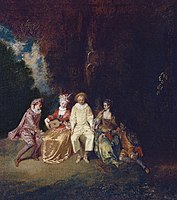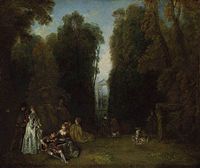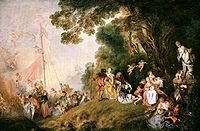Jean-Antoine Watteau
Yi palo
| Jean-Antoine Watteau | |
|---|---|
| Tuma |
Jean-Antoine Watteau (UK: /ˈwɒtoʊ/, US: /wɒˈtoʊ/,[1][2] fr; Dolodolonima daa su o la kasi kom 10 October 1684 – ka o kpi 18 July 1721)[3] o daa nyɛla Faransi peenta-peenta.
Piligu biɛhigu mini wumsibu
[mali niŋ | mali mi di yibu sheena n-niŋ]Jean-Antoine Watteau[n. 1] nyɛla bɛ ni daa dɔɣi so Anashaara goli October yuuni 1684,[n. 2]tiŋa yuli booni Valenciennes,[12] di daa nyɛla tiŋa din be County of Hainaut ka daa naan yi nti pahi Burgundian mini Habsburg Netherlands zuɣu. Ŋuna n daa pahiri bihi ayi bihi anahi shɛba o laamba Jean-Philippe Watteau (1660–1720) mini Michelle Lardenois (1653–1727) ni daa dɔɣi ni.[n. 3][n. 4]

Anfooninima
[mali niŋ | mali mi di yibu sheena n-niŋ]- Pierrot Content, c. 1711–1712, Thyssen-Bornemisza Museum, Madrid.[19]
- La Perspective (View through the Trees in the Park of Pierre Crozat), c. 1715, Museum of Fine Arts, Boston
- Mezzetino, c. 1717–1720, Metropolitan Museum of Art, New York
- Quellnymphe, c. 1718, private collection
- The Love Song, c. 1717, National Gallery, London
- The Dance, c. 1716–1718, Gemäldegalerie, Berlin
- Actors of the Comédie-Française, between 1711–1718, Hermitage Museum, Saint Petersburg
- Fêtes Vénitiennes, c. 1718–1719, National Galleries of Scotland, Edinburgh
- The Love Lesson, c. 1716–1717, Nationalmuseum, Stockholm
- Les Plaisirs du Bal, c. 1717, Dulwich Picture Gallery, London
- La Surprise, c. 1718, Getty Center, Los Angeles
- La Boudeuse, c. 1715–1718, Hermitage Museum, Saint Petersburg[21]
- Pilgrimage to Cythera, c. 1718–1719, Charlottenburg Palace, Berlin
- The Italian Comedians, c. 1719–1721, National Gallery of Art, Washington, D.C.
- L'Enseigne de Gersaint, c. 1720–1721, Charlottenburg Palace, Berlin
- Ceres (Summer), c. 1717–1718, National Gallery of Art, Washington, D. C.
Noosi
[mali niŋ | mali mi di yibu sheena n-niŋ]- ↑ Tɛmplet:Cite LPD
- ↑ Tɛmplet:Cite EPD
- ↑ Wine, Humphrey; Scottez-De Wambrechies, Annie (1996). "Watteau". In Turner, Jane (ed.). The Dictionary of Art. 32. New York: Grove's Dictionaries. pp. 913–921. ISBN 1-884446-00-0 – via the Internet Archive. Also available via Oxford Art Online (subscription needed).
- ↑ Camesasca 1971, p. 83.
- ↑ Germain, Jean; Herbillon, Jules (2007). Dictionnaire des noms de famille en Wallonie et à Bruxelles (in French). Bruxelles: E. Racine. p. 1039. ISBN 978-2-87386-506-1. OCLC 159955388 – via Google Books.
- ↑ Pierret, Jean-Marie (1994). Phonétique historique du français et notions de phonétique générale. Leuven: Peeters. p. 107. ISBN 9068316087. ISSN 0779-1658 – via Google Books.
- ↑ Pohl, Jacques (1983). "Quelques caractéristiques de la phonologie du français parlé en Belgique". Langue française 60 (6): 30–41. DOI:10.3406/lfr.1983.5173.
- ↑ Grasselli, Rosenberg & Parmantier 1984, pp. 15–28, "Chronology".
- ↑ Grasselli, Rosenberg & Parmantier 1984, p. 16.
- ↑ Vangheluwe, Michel (1987). "Watteau à Valenciennes". In Moureau, François; Grasselli, Margaret (eds.). Antoine Watteau, 1684-1721: le peintre, son temps et sa légende. Paris, Genève: Champion — Slatkin. pp. 7–9. ISBN 2852030381.
- ↑ Michel 2008, p. 30.
- ↑ Levey, Michael (1993). Painting and sculpture in France 1700-1789. New Haven: Yale University Press. p. 29. ISBN 0300064942.
- ↑ Grasselli, Rosenberg & Parmantier 1984, p. 17.
- ↑ Voltaire (1784). "Le Temple du Goût". Oeuvres completes de Voltaire (in French). 12. Paris: Impr. de la Société littéraire-typographique. pp. 171 n. 6. OCLC 83543415 – via the Internet Archive.
Vateau eft un peintre flamand qui a travaillé à Paris, où il est mort il y a quelques années. Il a réussi dans les petites figures qu'il a dessinées & qu'il a très-bien grouppées; mais il n'a jamais rien fait de grand, il en était incapable.
- ↑ Frederick II of Prussia (1856). "72. A La Margrave de Baireuth (Ruppin, 9 novembre 1739)". Oeuvres de Frédéric Le Grand (in French). 27. Berlin: R. Decker. p. 75 – via the Internet Archive.
La plupart de mes tableaux sont de Watteau ou de Laucret, a tous deux peintres français de l'éeole de Brabant.
- ↑ Grasselli, Rosenberg & Parmantier 1984, pp. 505, 548.
- ↑ Woermann, Karl (1920). Die Kunst der mittleren Neuzeit von 1550 bis 1750 (Barock und Rokoko). Geschichte der Kunst aller Zeiten und Völker (in German). 5. Leipzig, Wien: Bibliographisches Institut. pp. 196. OCLC 1045561032 – via the Internet Archive.
In Valenciennes geboren, das Flandern damals erft vor kerzem an Frankreich verloren hatte, war Watteau von Haus aus Wallone.
- ↑ Huyghe, René (1962). "Watteau: Song of the Soul". Art and the Spirit of Man. Translated from the French by Norbert Guterman. New York: H. N. Abrams. p. 413. OCLC 1147729820 – via the Internet Archive.
Watteau was a Frenchman, but a Frenchman of recent vintage, for it was only in 1678, six years before he was born, that Valenciennes became French under the Treaty of Nijmegen. He was thoroughly French, for the province of Hainaut had always been French-speaking and culturally oriented to France. Watteau was not a Fleming, as his contemporaries liked to call him; he was a Walloon.
- ↑ Pierrot Content (en).
- ↑ Marriage Contract and Country Dance - The Collection - Museo Nacional del Prado.
- ↑ La Boudeuse (The Capricious Girl). Hermitagemuseum.org. State Hermitage Museum.
Kundivihira
[mali niŋ | mali mi di yibu sheena n-niŋ]Bibliography
[mali niŋ | mali mi di yibu sheena n-niŋ]- Camesasca, Ettore (1971) [first published in Italian in 1968]. The Complete Paintings of Watteau. Classics of the World's Great Art. Introduction by John Sunderland. New York: Harry N. Abrams. ISBN 0810955253. OCLC 143069 – via the Internet Archive.
- Crow, Thomas E. (1985). Painters and Public Life in Eighteenth-Century Paris. New Haven; London: Yale University Press. ISBN 0-300-03764-3. OCLC 1200566051 – via the Internet Archive.
- Dacier, Émile; Vuaflart, Albert; Herold, Jacques (1921–1929). Jean de Julienne et les graveurs de Watteau au XVIII-e siècle (in French). Paris: M. Rousseau. Volumes 1, 2, 3, and 4 available via the Heidelberg University Library repository
- Dormandy, Thomas (2000). The White Death: the History of Tuberculosis. New York University Press.
- Goncourt, Edmond et Jules de (1881). L'art du XVIIIme siècle [The Art of the Eighteenth Century] (in French). 1. Paris: G. Charpentier. OCLC 1048224230 – via the Internet Archive.
- Grasselli, Margaret Morgan; Rosenberg, Pierre & Parmantier, Nicole, eds. (1984). Watteau, 1684-1721 (PDF) (exhibition catalogue). National Gallery of Art. ISBN 0-89468-074-9. OCLC 557740787 – via the National Gallery of Art archive.
- Hind, Charles Lewis (1910). Watteau. London: T.C. & E.C. Jack – via the Internet Archive.
- Huyghe, René (1970) [1950]. Watteau: The Artist and His Drawings. Translated by Barbara Bray. New York: Braziller. ISBN 9780269027093. OCLC 556662493 – via the Internet Archive.
- Tɛmplet:Cite EB1911
- Levey, Michael (1966). Rococo to Revolution: Major Trends in Eighteenth-Century Painting. London: Thames and Hudson. OCLC 1036855531 – via the Internet Archive.
- Mauclair, Camille (1906). Antoine Watteau (1684-1721). Duckworth & Co – via the Internet Archive.
- Michel, Christian (2008). Le "célèbre Watteau" (in French). Genève: Droz. ISBN 978-2-600-01176-1. OCLC 1158803919.
- Mollett, John William (1883). Watteau. Illustrated Biographies of the Great Artists. London: S. Low, Marston, Searle & Rivington. OCLC 557720162 – via the Internet Archive.
- Perl, Jed (2009). Antoine's Alphabet: Watteau and His World. New York: Vintage Books. ISBN 978-0-307-38594-9.
- Phillips, Claude (1895). Antoine Watteau. Seeley and co. Limited. OCLC 729123867 – via the Internet Archive.
- Plax, Julie Anne (2000). Watteau and the Cultural Politics of Eighteenth-Century France. Cambridge etc.: Cambridge University Press. ISBN 0-521-64268-X. OCLC 803847893.
- Plomp, Michiel; Sonnabend, Martin (2016). Watteau: Der Zeichner (exhibition catalogue) (in German). München: Hirmer. ISBN 978-3-941399-66-2.
- Posner, Donald (1984). Antoine Watteau. London: Weidenfeld & Nicolson. ISBN 0-8014-1571-3. OCLC 10736607 – via the Internet Archive.
- Roland Michel, Marianne (1984). Watteau: an Artist of the Eighteenth Century. London: Trefoil. ISBN 0-86294-049-4. OCLC 1302554747 – via the Internet Archive.
- Roseberg, Pierre, ed. (1984). Vies anciennes de Watteau. Paris: Hermann. ISBN 2-7056-5985-4.
- Rosenberg, Pierre & Prat, Louis-Antoine (1996). Antoine Watteau: catalogue raisonné des dessins (in French). Paris: Gallimard-Electa. ISBN 2-07-015043-7. OCLC 463981169.
- Rosenberg, Pierre; Prat, Louis-Antoine & Eidelberg, Martin (2011). Watteau: The Drawings (exhibition catalogue). London: Royal Academy of Arts. ISBN 9781905711703. OCLC 740683643.
- Schneider, Pierre (1967). The World of Watteau. New York: Time-Life Books. OCLC 680174683 – via the Internet Archive.
- Sheriff, Mary D., ed. (2006). Antoine Watteau: Perspectives on the Artist and the Culture of His Time. Newark: University of Delaware. ISBN 978-0-87413-934-1. OCLC 185456942.
- Staley, Edgcumbe (1902). Watteau and His School. London: George Bell and Sons – via the Internet Archive.
- Stein, Perrin (October 2003). Antoine Watteau (1684–1721) (essay). Heilbrunn Timeline of Art History. Metropolitan Museum of Art.
- Vidal, Mary (1992). Watteau's Painted Conversations: Art, Literature, and Talk in Seventeenth- and Eighteenth-Century France. New Haven, London: Yale University Press. ISBN 0-300-05480-7. OCLC 260176725.
- Walsh, Linda (1999). "Subjects, Society, Style: Changing Evaluations of Watteau and His Art". In Barker, Emma; Webb, Nick; Woods, Kim (eds.). The Changing Status of the Artist. Art and Its Histories. 2. New Haven, London: Yale University Press. pp. 220–248. ISBN 0-300-07740-8. OCLC 1148191287 – via the Internet Archive.
- The Watteau Society Bulletin, London.
- Martin Eidelberg, watteauandhiscircle.org
External links
[mali niŋ | mali mi di yibu sheena n-niŋ]- Tɛmplet:Art UK bio
- Alphabetical list of accepted paintings and copies at A Watteau Abecedario
- The Rococo and Watteau
- www.Jean-Antoine-Watteau.org 89 works by Antoine Watteau
- Watteau paintings at the Web Gallery of Art
- Bell, Julian (12 February 2009). "The Pleasure of Watteau". The New York Review of Books. Retrieved 3 May 2020.
- Works by Watteau in the collection of the Cooper-Hewitt, National Design Museum
- The Watteau Abecedario http://watteau-abecedario.org/default.htm
- ↑ The surname Watteau is presumed to originate from the word gâteau (Tɛmplet:Trans), possibly alluding to the trade carried on by the painter's distant ancestors;[4][5] according to Mollett 1883, p. 11, "In the old Walloon language the W is substituted for G, and the very name 'Wallon' is derived from 'Gallus.' 'Watteau' stands for 'Gateau,' as 'William' does for 'Guillaume,' &c." In French, the surname is usually pronounced with the voiced labiodental fricative fr,[6] though in Hainaut, the pronunciation with the voiced labio-velar approximant fr is present.[7]
Various spelling of the surname notably include Wateau, Watau, Vuateau, Vateau, and Vatteau.[8]A chirim ya:&It;ref>tuma maa yi laɣingu din yuli nyɛ "n.", ka lee bi saɣiritiri$It;references group ="n."/>tuka maa bon nya - ↑ It is generally agreed that Watteau was the Jean-Antoine Watteau baptised on 10 October 1684, in Valenciennes at the Eglise de Saint-Jacques.[9] However, it has been suggested by Michel Vangheluwe in 1984 that the painter could be the Antoine Watteau born on 6 May 1676, eight years before the traditional date.[10][11]A chirim ya:
&It;ref>tuma maa yi laɣingu din yuli nyɛ "n.", ka lee bi saɣiritiri$It;references group ="n."/>tuka maa bon nya - ↑ Jean-Philippe Watteau and Michelle Lardenois, married on 7 January 1681, had four sons: Jean-François (b. 1682), Jean-Antoine, Antoine Roch (1687–1689), and Noël Joseph (1689–1758).[13]A chirim ya:
&It;ref>tuma maa yi laɣingu din yuli nyɛ "n.", ka lee bi saɣiritiri$It;references group ="n."/>tuka maa bon nya - ↑ Contemporary authors disputed if Watteau could be considered as a Frenchman, given his origin from a recently seized region. In The Temple of Taste, Voltaire described Watteau as a Flemish artist;[14] similarly, Frederick the Great labeled Watteau and Nicolas Lancret as "French painters of the school of Brabant" in a letter to his sister, the Margravine of Brandenburg-Bayreuth.[15][16] Nonetheless, later authors, such as Karl Woermann[17] and René Huyghe,[18] define Watteau as a Walloon.A chirim ya:
&It;ref>tuma maa yi laɣingu din yuli nyɛ "n.", ka lee bi saɣiritiri$It;references group ="n."/>tuka maa bon nya
Pubu pubu:
- Articles which use infobox templates with no data rows
- Articles with short description
- Short description with empty Wikidata description
- Use dmy dates from September 2024
- Articles with invalid date parameter in template
- CS1 French-language sources (fr)
- CS1 German-language sources (de)
- Lahabaya zaa
- Ninsala
- Peejinima din kundivira bi viɛla
- Pages with reference errors that trigger visual diffs




















